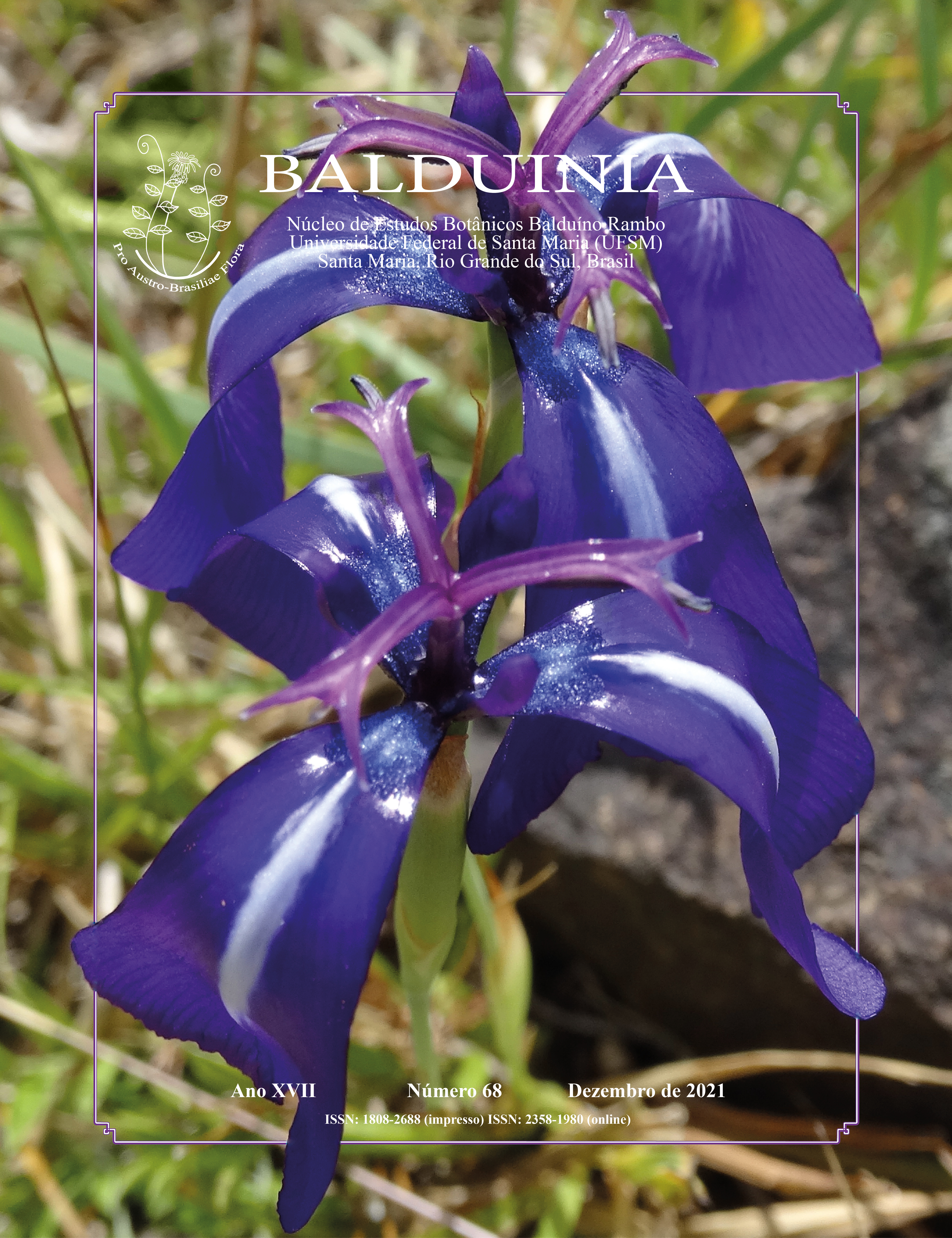Taxonomic review of the genus Kelissa Ravenna (Iridaceae)
DOI:
https://doi.org/10.5902/2358198069390Keywords:
Pampa biome, Grasslands, Cypelloid, TigridieaeAbstract
Abstract. Taxonomic review of the genus Kelissa Ravenna (Iridaceae)
A taxonomic review of the genus Kelissa is carried out. This genus is constituted by a single species, Kelissa brasiliensis, endemic to the state of Rio Grande do Sul, Brazil. Kelissa brasiliensis prospers in mountainous regions associated with grasslands, mainly in the southeastern part of the state of Rio Grande do Sul, but with populations extending to the central and western regions of the state. Kelissa brasiliensis is described and illustrated in detail and its geographic distribution is represented on a map. Data on etymology, geographic distribution, habitat, phenology, conservation, uses and vernacular names are provided, as well as discussions of taxonomic relationships of Kelissa with related taxa. A dichotomous key for distinguishing the genera of Iridaceae-Tigridieae from South America is presented.
Key Words: Pampa Biome, Grasslands, Cypelloid, Tigridieae.
Downloads
References
Baker, J.G. 1877. Systema Iridacearum. Journal of Linnean Society, Botany 16: 61–180. http://dx.doi.org/10.1111/j.1095-8339.1877.tb00172.x DOI: https://doi.org/10.1111/j.1095-8339.1877.tb02314.x
Baker, J.G. 1892. Handbook of the Irideae. George Bells & Sons, London. 248 pp. http://dx.doi.org/10.5962/bhl.title.15431 DOI: https://doi.org/10.5962/bhl.title.15431
Beentje, H. 2010. The Kew Plant Glossary: an illustrated dictionary of plant terms. Royal Botanic Gardens, Kew, 160 pp.
Cabrera, Á. L. & A. Willink. 1980. Biogeografía de América Latina. Secretaría General de la OEA, Monografía, 13, 122pp.
Chauveau, O., L. Eggers, T.T. Souza-Chies & S. Nadot. 2012. Oil-producing flowers within the Iridoideae (Iridaceae): evolutionary trends in the flowers of the New World genera. Annals of Botany London 110: 713-729. http://dx.doi.org/10.1093/aob/mcs134 DOI: https://doi.org/10.1093/aob/mcs134
Deble, L.P. & Alves, F.S. 2020. Cypella (Iridaceae): What do we know about the diversity of the genus? Balduinia 66 : 2–27.
https://doi.org/10.5902/2358198053318 DOI: https://doi.org/10.5902/2358198053318
Decreto lei nº 52109, de 1 de dezembro de 2014. Espécies da flora nativa ameaçadas de extinção no estado do Rio Grande do Sul, Brasil, 34pp.
Florschultz, P. A. & Grolle. R. 1975. Herbertus Gray 1821, Herbertia Sweet 1827 and Herberta Gray mut. Lindb 1875. Journal of Bryology, Oxford. 8: 479–481. DOI: https://doi.org/10.1179/jbr.1975.8.4.479
Goldblatt, P. 1975. Revision of the bulbous Iridaceae of North America. Brittonia 27: 373–385. DOI: https://doi.org/10.2307/2805516
Goldblatt, P. 1978. Herbertia (Iridaceae) reinstated as a valid generic name. Annals of the Missouri Botanic Garden 64: 378–379. DOI: https://doi.org/10.2307/2395348
Goldblatt, P. & Manning, J. C. 2008. The Iris Family. Natural History and Classification. Portland: Timber Press. 290p.
Herbert, W. 1840. Gelasine azurea. Azure Gelasine. Curtis’s Botanical Magazine 66: pl. 3779.
Herbert, W. 1842. Herbertia Drummondiana. Edward’s Botanical register 28: 65.
IUCN Standards and Petitions Committee (2019) Guidelines for Using the IUCN Red List Categories and Criteria. Version 14. IUCN Species Survival Commission. IUCN, Gland, Switzerland and Cambridge, UK. https://iucnredlist.org/redlist/content/attachmentfiles/RedListGuidelines.pdf
Klatt, F. W. 1862. Specimen e familia Iridearum. Linnaea 31: 533-570.
Kuntze, C.E.O. 1898. Revisio Generum Plantarum: vascularium omnium atque cellularium multarum secundum leges nomeclaturae internationales cum enumeratione plantarum exoticarum in itinere mundi collectarum ... Leipzig 3(1–3): 1–576.
https://doi.org/10.5962/bhl.title.327 DOI: https://doi.org/10.5962/bhl.title.327
Marchiori, J.N.C. 2004. Fitogeografia do Rio Grande do Sul: Campos sulinos. Est, Porto Alegre, 110pp.
Ravenna, P.F. 1981a. Kelissa a new genus of Iridaceae from South Brazil. Adansonia 1: 105-110.
Ravenna, P.F. 1981b. Sympa a new genus of Iridaceae from Rio Grande do Sul, Brazil. Wrightia 7 (1): 10–11.
Ravenna, P.F. 1989. A new species of Herbertia (Iridaceae) from SE South America. Nordic Journal of Botany 9: 55–56. DOI: https://doi.org/10.1111/j.1756-1051.1989.tb00984.x
Ravenna, P. 2009. A survey in the genus Cypella and its allies (Iridaceae). Onira Botanical Leaflets 12 (1): 1-11.
Roitman, G.G. & J.A. Castillo. 2007. Novedades taxonómicas y nomenclaturales para la flora vascular del conosur de Sudamérica: nuevas combinaciones en Iridaceae. Darwiniana 45: 236-241.
Roitman, G.G., I. Maza & J.A. Castillo. 2008. Iridaceae. In: Zuloaga, F.O., O. Morrone & M.J. Belgrano (eds.) Catálogo de Plantas Vasculares del Cono Sur 1. Monographs in Botany from the Missouri Botanical Garden 107: 423–453.
Sweet, R. 1827. Herbertia pulchella. Plaited leaved Herbertia. The British flower garden: containing coloured figures & descriptions of the most ornamental & curious hardy herbaceous plants ... London 3: pl. 222.
Thiers, B. [continuing database]. Index Herbariorum: A global directory of public herbaria and associated staff. New York Botanical Garden´s Virtual Herbarium. Available from: http://sweetgum.nybg.org/ih/ (accessed 17 October 2021).
Soriano, A., R.J.C. León, O.E. Sala, R.S. Lavado, V.A. Deregibus, O. Cahuepé, A. Scaglia, C.A.Velazquez, & J.H. Lemcoff. 1992. Río de la Plata grasslands. In: Coupland, R.T. (Ed.) Ecosystems of the World. Natural Grasslands. Introduction and Western Hemisphere. Elsevier, Amsterdam, p. 367-407.
Published
How to Cite
Issue
Section
License
Copyright (c) 2022 Balduinia

This work is licensed under a Creative Commons Attribution-NonCommercial-ShareAlike 4.0 International License.
Autores que publicam nesta revista concordam com os seguintes termos:
- Autores mantém os direitos autorais e concedem à revista o direito de primeira publicação, com o trabalho simultaneamente licenciado sob a Licença Creative Commons Attribution (CC-BY-NC-SA) que permite o compartilhamento do trabalho com reconhecimento da autoria e publicação inicial nesta revista, não comercial e compartilha igual.
- Autores têm autorização para assumir contratos adicionais separadamente, para distribuição não-exclusiva da versão do trabalho publicada nesta revista (ex.: publicar em repositório institucional ou como capítulo de livro), com reconhecimento de autoria e publicação inicial nesta revista.
- Autores têm permissão e são estimulados a publicar e distribuir seu trabalho online (ex.: em repositórios institucionais ou na sua página pessoal) a qualquer ponto antes ou durante o processo editorial, já que isso pode gerar alterações produtivas, bem como aumentar o impacto e a citação do trabalho publicado (Veja O Efeito do Acesso Livre).







